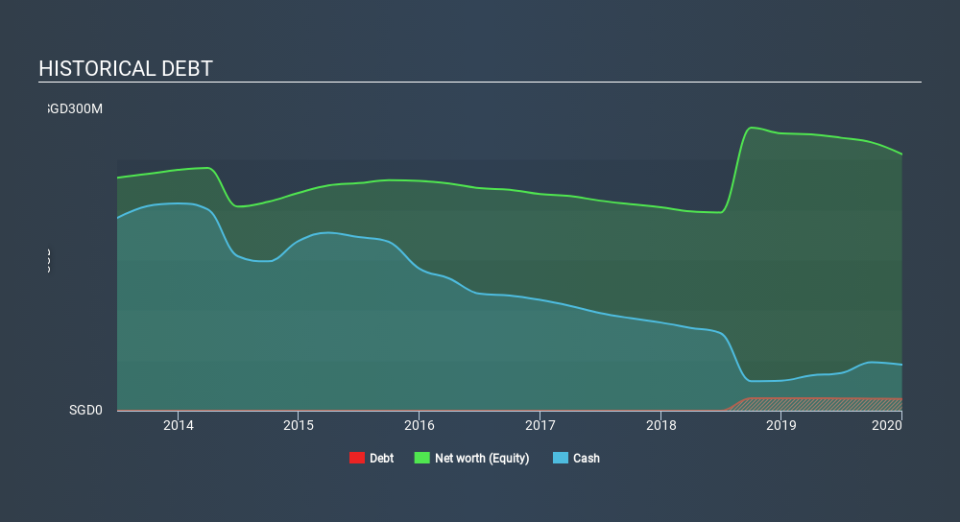Is Baker Technology (SGX:BTP) Using Too Much Debt?

Warren Buffett famously said, 'Volatility is far from synonymous with risk.' So it might be obvious that you need to consider debt, when you think about how risky any given stock is, because too much debt can sink a company. Importantly, Baker Technology Limited (SGX:BTP) does carry debt. But is this debt a concern to shareholders?
Why Does Debt Bring Risk?
Generally speaking, debt only becomes a real problem when a company can't easily pay it off, either by raising capital or with its own cash flow. In the worst case scenario, a company can go bankrupt if it cannot pay its creditors. However, a more frequent (but still costly) occurrence is where a company must issue shares at bargain-basement prices, permanently diluting shareholders, just to shore up its balance sheet. By replacing dilution, though, debt can be an extremely good tool for businesses that need capital to invest in growth at high rates of return. The first step when considering a company's debt levels is to consider its cash and debt together.
See our latest analysis for Baker Technology
How Much Debt Does Baker Technology Carry?
The image below, which you can click on for greater detail, shows that Baker Technology had debt of S$11.8m at the end of December 2019, a reduction from S$12.5m over a year. But on the other hand it also has S$45.8m in cash, leading to a S$34.1m net cash position.
A Look At Baker Technology's Liabilities
Zooming in on the latest balance sheet data, we can see that Baker Technology had liabilities of S$27.6m due within 12 months and liabilities of S$13.6m due beyond that. Offsetting this, it had S$45.8m in cash and S$29.2m in receivables that were due within 12 months. So it actually has S$33.7m more liquid assets than total liabilities.
This surplus liquidity suggests that Baker Technology's balance sheet could take a hit just as well as Homer Simpson's head can take a punch. With this in mind one could posit that its balance sheet is as strong as beautiful a rare rhino. Simply put, the fact that Baker Technology has more cash than debt is arguably a good indication that it can manage its debt safely. When analysing debt levels, the balance sheet is the obvious place to start. But you can't view debt in total isolation; since Baker Technology will need earnings to service that debt. So when considering debt, it's definitely worth looking at the earnings trend. Click here for an interactive snapshot.
In the last year Baker Technology wasn't profitable at an EBIT level, but managed to grow its revenue by 97%, to S$64m. Shareholders probably have their fingers crossed that it can grow its way to profits.
So How Risky Is Baker Technology?
Although Baker Technology had negative earnings before interest and tax (EBIT) over the last twelve months, it generated positive free cash flow of S$14m. So taking that on face value, and considering the net cash situation, we don't think that the stock is too risky in the near term. Given it also grew revenue by 97% over the last year, we think there's a good chance the company is on track. So this may well be an interesting business to watch grow. The balance sheet is clearly the area to focus on when you are analysing debt. However, not all investment risk resides within the balance sheet - far from it. For instance, we've identified 3 warning signs for Baker Technology (1 shouldn't be ignored) you should be aware of.
When all is said and done, sometimes its easier to focus on companies that don't even need debt. Readers can access a list of growth stocks with zero net debt 100% free, right now.
If you spot an error that warrants correction, please contact the editor at editorial-team@simplywallst.com. This article by Simply Wall St is general in nature. It does not constitute a recommendation to buy or sell any stock, and does not take account of your objectives, or your financial situation. Simply Wall St has no position in the stocks mentioned.
We aim to bring you long-term focused research analysis driven by fundamental data. Note that our analysis may not factor in the latest price-sensitive company announcements or qualitative material. Thank you for reading.

